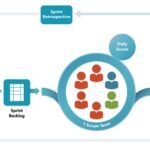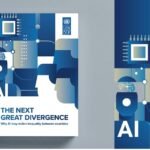
The Waterfall Methodology, also known as the “cascade methodology,” has been a cornerstone in the history of project management, offering a structured and sequential process that has been both praised and criticized.
Waterfall has traditionally been the model used in project management; however, the emergence of Industry 4.0 and Industry 5.0 is significantly transforming project management and product development (Ghena y Ghiculescu, 2023), which necessitates adapting these methodologies to new challenges.
This article explores the origins, phases, advantages, and disadvantages of the Waterfall methodology. Additionally, a comparison between the Waterfall Model and Agile methodology is presented to help you decide which approach might be more suitable for your project.
Origins of the Waterfall Methodology
The Waterfall methodology is a linear and sequential approach to project management and software development. It was first introduced in the 1950s and has since been widely adopted across various industries. The model is called “waterfall” because the process flows downward through a series of phases, similar to how water cascades down a waterfall.
The Waterfall methodology was originally developed in the context of software engineering to manage the complex and large-scale projects of that era. Essentially, the cascade model is designed to ensure that each phase of a project is completed before the next one begins, minimizing the risk of changes disrupting the process.
What is the Waterfall Methodology?
The Waterfall methodology is a sequential approach to project management and software development, where each phase must be completed before the next one begins. This methodology, which has its origins in the manufacturing and construction industries, is structured to follow a linear path, ensuring that each stage is fully developed before moving on to the next (Pargaonkar, 2023).
The Waterfall method, also known as the traditional method, is known for its clear milestones, documentation, and structured environment, making it a popular choice for projects where the requirements are well understood from the beginning.
Phases of the Waterfall Methodology
The Waterfall methodology divides the project into distinct phases, each with its own set of deliverables and objectives. The completion of one phase is a prerequisite for the next, making it a truly sequential process. The Waterfall model typically includes 5 characteristic phases; however, the following breakdown includes 6 stages to better detail each one:
Requirement Gathering
The first phase of the Waterfall methodology is requirement gathering. This stage involves collecting all necessary information from stakeholders to understand the project’s objectives. In software development, this means defining what the software is supposed to do, identifying user needs, and specifying system requirements. This is a critical phase because any errors or omissions can have significant impacts later in the project.
System Design
Once the requirements are clearly understood, the next phase is system design. This involves creating the system architecture, specifying hardware and software requirements, and designing system models and workflows. The design phase is divided into two sub-phases: High-Level Design (HLD) and Detailed Design (DD). HLD describes the overall system architecture, while DD focuses on finer details like data models and algorithms.
Implementation (Coding)
The implementation phase is where the actual coding of the software takes place. Developers translate the system design into source code. This phase is usually the most time- and resource-intensive, as it involves writing, testing, and debugging the software.
Integration and Testing
Once the code is written, the integration and testing phase begins. This stage involves integrating all the different components of the system and testing them as a whole. The goal is to identify and fix errors, ensure the system meets the requirements, and confirm that all components work together as intended.
Deployment
Once the system has been tested and is deemed ready, it is deployed in the production environment. This phase includes installation, configuration, and possibly user training. The deployment phase is crucial as it marks the transition from development to operational use.
Maintenance
The final phase of the Waterfall model is maintenance. Once the system is deployed, it needs to be maintained to ensure it continues to function smoothly. This phase involves making updates, fixing bugs, and providing user support. Maintenance can be a long-term commitment, often lasting throughout the software’s lifecycle.
Advantages of the Waterfall Methodology
The Waterfall methodology offers several benefits that make it an attractive option for certain types of projects. Understanding these advantages can help you determine if it is the right approach for your project.
Simplicity and Structure
The linear nature of the Waterfall model makes it easy to understand and manage. Each phase has clear objectives and deliverables, providing a structured framework that is easy to follow. This simplicity is particularly beneficial for projects with well-defined requirements and outcomes. According to Pargaonkar (2023), project managers find it relatively easier to manage Waterfall projects, as fixed requirements and well-defined phases allow for efficient resource allocation, task assignment, and progress tracking.
Clear Documentation
Since each phase of the Waterfall model must be completed before the next one begins, it naturally results in thorough documentation. This is especially valuable in regulated industries where documentation is required for compliance purposes. Detailed documentation ensures that every aspect of the project is well-documented, facilitating handovers and future maintenance.
Early Problem Detection
The sequential process of the Waterfall methodology allows for issues to be identified and addressed early in the development cycle. For example, comprehensive requirement gathering and design phases can prevent costly changes or rework later in the project.
Disadvantages of the Waterfall Method
Despite its advantages, the Waterfall methodology is not without its drawbacks. These limitations may make it less suitable for certain types of projects, particularly those that are complex, dynamic, or innovative.
Inflexibility
One of the major criticisms of the Waterfall model is its rigidity. The sequential nature of the process makes it difficult to revisit earlier phases if changes are needed. Once a phase is completed, revisiting it often requires significant effort and can disrupt the entire project schedule.
Lack of Client Involvement
Pargaonkar (2023) highlights that one of the main disadvantages of the Waterfall method is that client involvement is typically limited to the early stages of the project, during requirement gathering. This can lead to a lack of ongoing feedback, making it difficult to adapt to changing client needs and preferences.
Risk of Misinterpretation
In the Waterfall methodology, requirements must be fully understood and documented before development begins. However, this can lead to problems if the initial requirements were misunderstood or if stakeholder needs evolve during the project. The lack of iterative feedback can result in a final product that does not fully meet user needs.
Delayed Testing
In the Waterfall method, testing is generally conducted after the implementation phase. These delayed tests mean that critical issues or defects may only be discovered in a later stage of the project, making it more costly and time-consuming to fix them.
Not Suitable for Complex Projects
Complex projects with uncertain or changing requirements are not well-suited to the Waterfall methodology. Pargaonkar (2023) points out that the methodology’s inability to adapt to changing circumstances can lead to unsatisfactory outcomes and difficulty in meeting evolving business needs.
When to Use the Waterfall Methodology
The Waterfall methodology is best used in situations where:
- The project scope and requirements are clearly defined and unlikely to change.
- The client prefers a structured and documented process.
- The project is large-scale and requires careful planning and execution.
- Stable and Experienced Teams: A team with experience in Waterfall and capable of working sequentially is required.
- Well-Defined Scope: The project scope should be well-defined with no significant changes expected.
Examples include construction projects, software development, and other highly regulated industries.
Best Practices for Implementing the Waterfall Methodology in Software Development
When implementing the Waterfall methodology in software development, it is essential to follow best practices to maximize success:
- Thorough Requirement Analysis: Invest significant time in the requirement gathering phase to ensure all client needs are understood and documented. Chari y Agrawal (2018) studied three types of requirement defects: incorrect requirements, incomplete requirements, and new requirements. They found that addressing change requests due to new requirements increases defects and effort; resolving change requests due to incorrect requirements increases the number of new requirements and defects; and addressing change requests due to incomplete requirements has no measurable impact on software project outcomes.
- Detailed Documentation: Maintain comprehensive documentation at each stage to support future maintenance and updates.
- Effective Communication: Communicate regularly with stakeholders to manage expectations and ensure the project stays on track.
- Early Risk Identification: Identify potential risks early in the process to avoid costly issues later in the project.
Agile vs. Waterfall: A Comparative Analysis
In recent years, the Agile methodology has emerged as a popular alternative to the Waterfall model, particularly in software development and project management. Agile is known for its flexibility, iterative development, and client-centered approach. Osemeike et al., (2024) explores the integration of Agile and Waterfall approaches as a strategic response to improve project effectiveness and efficiency, concluding that combining Agile and Waterfall methodologies represents a paradigm shift in project management by offering a holistic framework that balances structured planning with adaptive execution.
Let’s compare the two methodologies to understand their key differences and when each might be more appropriate.
Flexibility and Iteration
While Waterfall is a linear process, Agile is iterative and incremental. Agile allows for changes and revisions at any stage of the project, which is particularly useful in dynamic environments where requirements may evolve. This flexibility contrasts sharply with the rigidity of the Waterfall model, making Agile more adaptable to change.
Client Collaboration
Agile emphasizes continuous collaboration with the client throughout the project. This ensures the final product closely aligns with client needs as feedback is collected and incorporated in each iteration. In contrast, Waterfall typically involves client interaction mainly during the requirement gathering phase, which can lead to misalignments if client needs change.
Speed to Market
Agile’s iterative approach often leads to faster delivery of functional software, as development and testing are conducted simultaneously in short cycles known as sprints. This can be particularly advantageous for projects where time to market is critical. Waterfall, on the other hand, may result in longer project durations due to its sequential nature.
Documentation and Formality
The emphasis of Waterfall on documentation is both an advantage and a limitation. While it provides detailed records, it can also slow down the process. Agile, conversely, prioritizes functional software over comprehensive documentation, which can speed up development but may result in less formalized records.
How to Choose the Right Methodology for Your Project
The choice between Waterfall and Agile should be guided by the specific needs and constraints of your project. Iwersen et al., (2023) suggests using the Analytic Hierarchy Process (AHP) method to assess and select the best project management methodology for research and development projects.
Here are some considerations to help you decide:
Project Requirements
If your project has well-defined and stable requirements with a clear end goal, the Waterfall model may be a good choice. Its structured approach can ensure that all requirements are thoroughly addressed. However, if requirements are likely to change or are not fully understood from the beginning, Agile may be a better option due to its flexibility.
Stakeholder Involvement
Waterfall may be suitable for projects where stakeholder involvement is limited to the early phases and where detailed documentation is required. Conversely, Agile is ideal for projects that require ongoing stakeholder participation and feedback.
Project Complexity and Risk
For complex projects with high uncertainty, Agile’s iterative approach allows for better risk management. The ability to adapt and change direction as new information emerges can be crucial for managing complex projects. Waterfall, with its linear approach, may be more suitable for less complex projects where risk is lower and the process is straightforward.
Time Constraints
If rapid delivery is essential, Agile’s sprint-based approach can lead to faster releases of functional software. Waterfall may be slower due to its sequential nature, but it offers the advantage of a more predictable schedule, which can be important for projects with strict deadlines.
Case Studies: Waterfall in Action
To illustrate the application of the Waterfall methodology, here are some real-world examples where this approach has been successfully implemented:
Construction Projects
In the construction industry, Waterfall is often the preferred methodology due to its sequential nature, which aligns well with the step-by-step process of infrastructure construction. The clear stages of planning, design, construction, and testing reflect Waterfall phases, ensuring that each phase is completed before moving to the next. Marques et al., (2023) researched suitable project management methodologies for the construction industry in Macao and recommends a hybrid approach combining Waterfall and Agile methodologies as a tool for project management.
Software Development
Many large companies have used Waterfall to develop complex, large-scale software systems where requirements are well-defined and changes are minimal. The Waterfall model’s emphasis on documentation and thorough prior planning has made it a reliable choice for such projects. Renjani et al., (2023) redesigned an immunization information system to help manage medical records and maintain the quality of healthcare services using the Waterfall method.
The Future of the Waterfall Methodology
While Agile has become increasingly popular, especially in software development, the Waterfall methodology still has a place in project management. Its structured approach, emphasis on documentation, and suitability for projects with stable requirements mean it will continue to be used in certain contexts. Rahman et al., (2024) reports that transitioning from a Waterfall to an Agile method in a software company can increase the number of requirement-related defects introduced in the developed software.
However, in the future, there may be more hybrid models, where elements of both Waterfall and Agile are combined to leverage the strengths of both methodologies. For example, some projects may use Waterfall for the initial planning and design phases, and then switch to Agile for implementation and testing.
Iwersen et al. (2023) recommends that a hybrid methodology is well-suited for complex projects, combining best practices and emerging techniques in project management; while Gado et al., (2024) concludes that Agile is a good option for projects with changing requirements or uncertain outcomes, whereas Waterfall is more appropriate for projects with well-defined requirements and a need for strict control.
Conclusion
The Waterfall methodology has been a fundamental approach in project management for decades and has been primarily used in software development. Its structured and sequential process is suitable for projects with clear requirements and a need for rigorous documentation. However, its inflexibility and potential for late feedback make it less ideal for projects where requirements may change or evolve.
The Agile methodology, with its iterative and flexible nature, offers an alternative that better adapts to dynamic and uncertain environments. The choice between Waterfall and Agile should be based on the specific needs of the project, including factors such as stakeholder involvement, project complexity, and time constraints.
While Waterfall may sometimes be considered outdated compared to the rise of Agile, it remains a viable and effective approach for many types of projects, particularly those that benefit from its structured and methodical nature.
References
Chari, K., Agrawal, M. Impact of incorrect and new requirements on waterfall software project outcomes. Empir Software Eng 23, 165–185 (2018). https://doi.org/10.1007/s10664-017-9506-4
Gado, Nevine G. Dr. and Elsayed, Noha A, Dr (2024) “Agility Opportunities in Construction Project Management “Exploring Opportunities in Construction Projects in integration with Waterfall Methodology.” Journal of Engineering Research: Vol. 8: Iss. 3, Article 5.
Ghena, M. F., & Ghiculescu, L. D. (2023). Applicability of Waterfall and Agile Methodologies. FAIMA Business & Management Journal, 11(4), 55-65.
Iwersen, L. H. L., Zem, L., & Penteado Neto, R. de A. (2023). CHOOSING THE BEST PROJECT MANAGEMENT METHODOLOGY FOR RESEARCH AND DEVELOPMENT PROJECTS: AGILE, WATERFALL, OR HYBRID?. REVISTA FOCO, 16(11), e3336. https://doi.org/10.54751/revistafoco.v16n11-112
MARQUES, Joao Alexandre Lobo; MORAIS, João José Bragança dos Reis; ALVES, José; GONÇALVES, Marcus. EFFECTIVENESS ANALYSIS OF WATERFALL AND AGILE PROJECT MANAGEMENT METHODOLOGIES – A CASE STUDY FROM MACAU’S CONSTRUCTION INDUSTRY. Revista Gestão em Análise, Fortaleza, v. 12, n. 1, p. 23–38, 2023. DOI: 10.12662/2359-618xregea.v12i1.p23-38.2023.
Osemeike Gloria Eyieyien, Courage Idemudia, Patience Okpeke Paul, & Tochukwu Ignatius Ijomah. (2024). Advancements in project management methodologies: Integrating agile and waterfall approaches for optimal outcomes. Engineering Science & Technology Journal, 5(7), 2216-2231. https://doi.org/10.51594/estj.v5i7.1312
Pargaonkar, S. (2023). A Comprehensive Research Analysis of Software Development Life Cycle (SDLC) Agile & Waterfall Model Advantages, Disadvantages, and Application Suitability in Software Quality Engineering. International Journal of Scientific and Research Publications (IJSRP), 13(08), 345-358.
Rahman, A., Cysneiros, L. M., & Berry, D. M. (2024, April). An Empirical Study of the Impact of Waterfall and Agile Methods on Numbers of Requirements-Related Defects. In Proceedings of the 39th ACM/SIGAPP Symposium on Applied Computing (pp. 1143-1152).
Renjani, A. S., Syahidin, Y., Sari, I., & Sukmawijaya, J. (2023). Implementation of Childhood Immunization Program Using the Waterfall Method. JURTEKSI (Jurnal Teknologi dan Sistem Informasi), 9(3), 361-368.
Editor and founder of “Innovar o Morir” (‘Innovate or Die’). Milthon holds a Master’s degree in Science and Innovation Management from the Polytechnic University of Valencia, with postgraduate diplomas in Business Innovation (UPV) and Market-Oriented Innovation Management (UPCH-Universitat Leipzig). He has practical experience in innovation management, having led the Fisheries Innovation Unit of the National Program for Innovation in Fisheries and Aquaculture (PNIPA) and worked as a consultant on open innovation diagnostics and technology watch. He firmly believes in the power of innovation and creativity as drivers of change and development.





